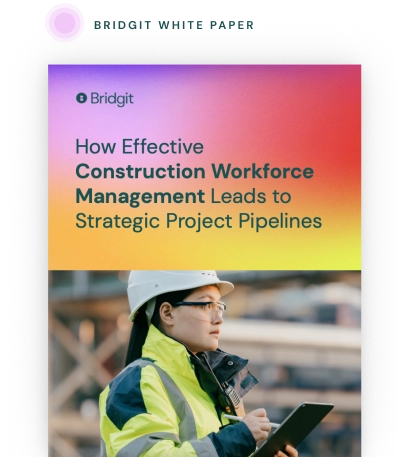The effects of cost overruns in construction projects can be devastating. Construction is a very capital-intensive industry, which means overruns on even a single project can jeopardize payroll and equipment rentals elsewhere.
Table of Contents
In this post, we’ll look at the reasons for cost overruns in construction projects to help you better avoid them.
10 reasons for cost overruns in construction projects
#1. Inaccurate estimates
An estimator’s job is among the most important in construction. By accurately projecting costs for materials, labor, and equipment, they can help companies price jobs to ensure profitability. When estimates are inaccurate, however, project financials can go off the rails very quickly.
In fact, according to a survey, roughly 30% of construction companies experience regular overruns due to profits being less than expected based on the estimate. Additionally, 25% of respondents reported that just two or three inaccurate estimates could put them out of business.
You can avoid this by making better use of construction management software. Procore, for example, has an entire suite of financial tools that will help you ensure accuracy in project costing and bid management.
In addition to making better use of technology, watch out for these common estimating mistakes:
-
failing to understand the project’s scope fully
-
not taking risks into account
-
making uneducated predictions
-
sending estimates out before properly reviewing them
-
neglecting to read subcontractor estimates thoroughly
-
being overly optimistic about currency exchange rates (when applicable)
#2. Poor planning and design
Cost overruns in construction projects are also often the result of poor designs and questionable planning. These mistakes can necessitate last-minute modifications, holding your project up substantially and costing thousands of dollars.
Again, a very easy way to avoid this sort of hassle is to use technology more effectively. Building information modeling programs can pinpoint potential problems long before workers begin construction.
Changing digital designs is also much easier than having physical sketches redrawn. In the latter scenario, you’d need to distribute those changes efficiently to avoid workers relying on outdated information.
#3. Failing to account for hidden costs
Not every cost is easy to predict, especially when dealing with humans.
Labor, in particular, can be hard to price, thanks to inefficiencies such as time theft, which can be more subtle and hard to detect than many construction companies think. Check out this article for tips on accurately calculating labor costs with these hidden expenses.
Other hidden costs some companies often fail to account for include permits, spontaneous changes, and unexpected cost increases between the estimating and procurement stages. This is where having an experienced construction financial team comes in handy.
#4. Assuming change orders won’t happen
Change orders are a common occurrence in construction, yet they still catch some companies by surprise. This can lead to cost overruns in construction projects when inadequate resources (including time) have been allocated to compensate for adjustments.
Matters are only made worse when a construction company doesn’t use adequate software to disseminate change orders to the appropriate parties soon enough.
In such a scenario, even a small change order can have ripple effects that throw the entire project’s financials out of balance.
Good project planning techniques and programs include the capacity to simulate various types of scope changes during the preconstruction phase. This proactive approach can help companies avoid the effects of cost overruns on construction projects.
#5. Poor scheduling
Construction resource management is among the most important aspects of any project. Done effectively, it can ensure resources are available when needed and help with forecasting and tracking.
Without good construction management software, you’ll find chronically over or under-utilized workers waiting for resources that aren’t where they should be.
Programs like Bridgit Bench can help you avoid this by tracking resource utilization, dependencies, etc.

Use your workforce data to create a competitive advantage
Download our white paper to see how effective workforce planning can help stay ahead of labor demands and create a strategic project pipeline.
#6. Not having the right workers in place
Not having the right workers in place can manifest in several ways.
For one, it can mean having the wrong workers around, which might lead to inefficiencies on the job site and inferior work, leading to cost overruns.
Construction companies are also increasingly impacted by labor shortages that have made workers in particular trades difficult (and therefore costly) to find.
Check out this article for tips on leveraging data to reduce construction skill gaps at your company.
#7. Failing to adapt quickly enough
The world changes at a breathtaking pace. Construction faces many of these changes head-on as one of the earth’s biggest and most integral industries. The companies that thrive are those that promptly adapt to these changes.
COVID-19 is a classic example of a time when being nimble offered substantial benefits for construction companies worldwide. Less flexible companies struggled to navigate the new world of material shortages and social distancing guidelines.
The increased reliance on remote workforce management technology also negatively impacted companies that have been slow to adopt digital technology into their workflow.
Digitization, in particular, tends to be a common roadblock among older construction companies. As discussed in this article, it’s one of a few areas analysts have been calling for serious change. Prompt digitization could save the industry billions of dollars yearly, thanks to reduced cost overruns on construction projects.
#8. Poor on-site management
Ineffective management on the job site can worsen inefficiencies like time theft. Workers in the front office and physical laborers don’t always see eye-to-eye on things, so companies need good job site management to bridge the gap and keep everyone happy.
Beyond managing interpersonal conflicts, job site management needs to understand the project’s scope and what it will take to deliver on time. Management should be able to make quick decisions using the correct tools and up-to-date information.
#9. Poor communication
Construction projects have numerous moving parts. If those parts aren’t synchronized, cost overruns are very likely. Your company will lack a single source of truth, which is one of the pitfalls of ineffective remote manpower planning.
Workers should have the skills and tools to facilitate proper communication between various stakeholders. This will ensure your project stays on track and budget.
#10. Administrative errors
We have administrative errors last on our list of reasons for cost overruns on construction projects. These can include things like:
-
miscommunication concerning accounting
-
poor document management
-
inappropriate micromanagement (instead of allowing professionals to make decisions based on their expertise)
Administrative errors can be greatly reduced by establishing a data-driven culture rather than one that relies on guesswork.
The effects of cost overruns in construction projects can be devastating. We hope this article has given you valuable insights into avoiding these pitfalls.
To summarize, avoiding cost overruns comes down to better management. Companies should strive to conduct better estimating, planning, and communication to keep projects moving forward on time and on budget.
If you found this useful, also check out how “Mallorie Brodie and Lauren Lake disrupted an industry“


